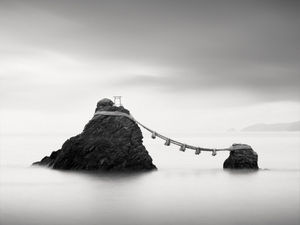top of page


Japan: Himeji Castle, the Grace of the White Heron
Himeji Castle, also known as "Hakuro-jō" or "Shirasagi-jō" (White Heron Castle), is one of the most remarkable examples of Japanese castle architecture. Its long history makes it a rare witness to the various periods from feudal Japan to the present day. It is a masterpiece of defensive and residential construction and a high-quality photographic subject. Fine Art Print © O. Robert (Purchase here) Himeji Castle is located in Hyōgo Prefecture in the beautiful city of Himeji. I


Shanshui and Sansui: Differences and Influence in Landscape Photography
Shanshui in China and Sansui in Japan are two concepts focused on the artistic representation of natural landscapes, though their...


Japan: The Great Tsunami of 2011, Already 10 Years
On March 11, 2021, Japan commemorates the 10th anniversary of the most significant tsunami in their history. On March 11, 2011, a violent...


Japan: Kami, Spirits of Nature and Ancestors in Shinto Tradition
Shintoism, the indigenous religion of Japan, centers around the worship of Kami, which are revered spirits or deities. The Kami can...


Landscapes and Minimalism: The Influence of Japanese Sansui in Photography
Sansui refers to the artistic representation of landscapes in Japan. A genre that has played a central role in traditional painting,...


Walking: Active Meditation and Tool of Inspiration in Photography
Since antiquity, walking has been considered an exercise that promotes reflection, concentration, and spiritual awakening. From...


Landscapes and Minimalism: The Influence of Chinese Shanshui in Photography
Shanshui (山水), which literally means "mountain-water" in Chinese, is an artistic and philosophical concept of landscape representation...


Japan: Jingu, Taisha, Jinja, the Hierarchy of Shinto Shrines
Shinto shrines in Japan are categorized into several groups, each with its specific significance and importance. Ranging from small local...


Member of the Jury for the B&W Minimalist Photography Award 2020
The prestigious magazine dedicated to black and white minimalist photography launched its first competition in 2020. I have the honor and...


China: Yuyuan, the Garden of Harmony and Health in Shanghai
Yuyuan Garden, located in the old town of Shanghai, is an outstanding example of the classical Chinese gardens of the southern Yangzi...


Japan: Shimenawa and Shide, Shinto Spiritual Symbols
The decorative and symbolic elements of Shinto shrines, such as shimenawa and shide, play a crucial role in Japanese tradition and...


China: The Residence of Hu Xueyan in Hangzhou, an Empire and its Decline
The Residence of Hu Xueyan in Hangzhou is a historic residential complex located in Hangzhou, Zhejiang Province. Hu Xueyan was a very...


Japan: Inuyama Castle, the Fortress of the White Emperor
Inuyama Castle, located in Aichi Prefecture, is one of the oldest existing Japanese castles. It is renowned for its original keep dating back to the Azuchi-Momoyama period. Its history is rich with events, important figures, and transitional periods. Situated atop a wooded hill, it makes for an interesting photographic subject. Fine Art Print © O. Robert (Purchase here) Inuyama Castle is a cornerstone of Japanese history, reflecting architectural evolutions, military conflict


Japan: Photographing the 88 Temples of the Henro Pilgrimage (Part 2)
The pilgrimage around the island of Shikoku, also known as Henro in Japanese, involves connecting 88 temples of Shingon Buddhism, spread across 4 prefectures. Several thousand pilgrims venture each year on these paths, which are about 1200 kilometers long. Traditionally, these pilgrims, called Ohenro, travel on foot this ambitious journey in a personal quest. Explanations and advice for photographing the temples and the grandiose landscapes of this pilgrimage. Fine Art Print


Japan: Henro, the Pilgrimage of the 88 Temples of Shikoku (Part 1)
The pilgrimage around the island of Shikoku, also known as Henro in Japanese, involves connecting 88 temples of Shingon Buddhism, spread across 4 prefectures. Several thousand pilgrims venture onto these paths spanning about 1200 kilometers every year. Traditionally, the pilgrims, called Ohenro, travel on foot on this ambitious journey in a personal quest. History, challenge, and organization of the most famous pilgrimage in Japan. Fine Art Print © O. Robert (Purchase here) E


Japan: The Meoto Iwa Rocks in Ise
The Japanese have a strong penchant for symbols. This is a well-established fact, and I have touched upon it several times in my articles. The Meoto Iwa rocks, located in Mie Prefecture in Ise, are undoubtedly among the most famous and photographed in the entire country. Tourists flock in large numbers throughout the year to visit this renowned series of rocks artfully arranged by Mother Nature along the coast, not far from the beautiful city of Ise. Fine Art Print © O. Rober


Japan: Photographing the Seaweed Cultures of the Ariake Sea
The Nori seaweed farms, with their entanglement of geometric nets, offer a unique landscape for photographers, especially in the field of minimalism. These structures lend themselves to interesting artistic compositions. They highlight the duality and ephemeral beauty of nature, as well as our intrinsic relationship with it. Fine Art Print © O. Robert (Purchase here) The Ariake Sea, located on the island of Kyushu, is known for being the country's largest inland bay. Characte


Japan: Matsue Castle, a National Treasure Standing the Test of Time
Matsue Castle, also known as "Pine Castle", is located in Shimane Prefecture, in the beautiful San-in region. It's one of the few castles in Japan whose main tower has survived wars and natural disasters since the Edo period, making it a precious testament to Japanese military architecture. An interesting relic in photography, especially at night. Fine Art Print © O. Robert (Purchase here) History of Matsue Castle Matsue Castle (松江城, Matsue-jō) was built between 1607 and 161


Publication in the Hundred Photographize Annual Book Best Selected, 2020
It is a great honor to be invited by the prestigious Photographize Magazine for a publication of my work in their annual book of the best...


Japan: Lake Biwa, a Cultural Gem and a Source of Artistic Inspiration
Lake Biwa, located in the Shiga Prefecture of Japan, is the country's largest freshwater lake and plays a crucial role both ecologically and culturally. It is renowned for its natural beauty, unique biodiversity, and historical significance. It has also been a source of inspiration for many photographers in recent years. Fine Art Print © O. Robert (Purchase here) Certainly, Lake Biwa is the most interesting lake I have had the pleasure of working on in the last 15 years, afte


Japan: 5 Essential Gardens for Landscape Photography
The art of Japanese gardens is imbued with mysteries. These miniature representations of imaginary or existing landscapes offer landscape architects an infinite margin for personal expression. Although these gardens can be classified into styles corresponding to specific periods, they remain peaceful places of contemplation for the visitor. Here is a selection of 5 historical gardens that have particularly fascinated me in all seasons. © O. Robert To offer scenes that challen


Japan: Nanzo-in, the Reclining Buddha Temple
Nanzo-in Temple, located in the quiet town of Sasaguri, Fukuoka Prefecture, is one of Japan’s most significant Buddhist temples. Known for its enormous reclining Buddha statue, which ranks among the largest bronze statues in the world, the temple has a history deeply rooted in the local area, offering visitors a rich blend of spiritual and cultural experiences. © O. Robert Nanzo-in Temple offers a blend of deep spiritual significance, natural beauty, and historical importance


Japan: The Nori Seaweed Farms of the Ariake Sea
Nori seaweed, emblematic of Japanese cuisine, embodies a rich tradition and a unique symbiosis between humans and the sea. It is in the heart of Ariake Bay, a distinctive region of Kyushu Island, that this ancestral tradition reaches its pinnacle. A craftsmanship that represents both the simplicity and the cultural richness of Japan. Fine Art Print © O. Robert (Purchase here) In the calm waters of Ariake, farmers, or rather "aquaculturists," engage in the meticulous cultivati


Japan: Tanajibu, the Fishing Huts on the Ariake Sea
Nestled in the heart of Kyushu's maritime landscapes, the Tanajibu, these traditional fishing huts, emerge as sentinels over the Ariake Sea. These structures, perched on stilts and battered by the tides, represent a fascinating chapter of harmony between man and sea, a living tableau of age-old traditions that defy time. Fine Art Print © O. Robert (Purchase here) In this article, I invite you to explore the world of the Tanajibu, delving into their construction, significance,
bottom of page



